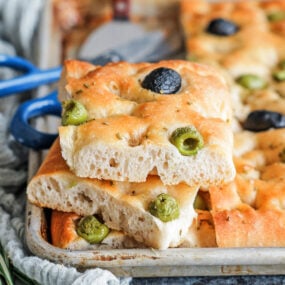

Olive Focaccia Recipe
This golden-brown Olive Focaccia, made with a biga starter and briny olives, is one of the easiest, most flavorful breads you’ll ever bake.
Ingredients
For the Biga:
- 2 ¼ cups bread flour
- 2/3 cup + 1 teaspoon filtered lukewarm water
- 1/3 teaspoon active dry yeast
For the Dough:
- 2 ¼ cups bread flour
- 1 1/3 cup + 1 teaspoon filtered lukewarm water
- 1 teaspoon active dry yeast
- 2 teaspoons coarse salt + ½ teaspoon
- 6 tablespoons olive oil
- ½ cup pitted green olives
- ½ cup pitted black olives
- 1 tablespoon finely minced fresh rosemary
Instructions
For the Biga:
- Add the flour, water, and yeast to a large bowl. Using your hands, gently mix and fold everything together to combine. This should take you about 3 to 4 minutes. Throughout making the biga, the dough will start to become really shaggy.
- Bring the shaggy dough together a bit more to form a loose ball. Then, transfer it to a plastic container with a lid, or you can leave it in the bowl covered with plastic.
- It can sit at a room temperature of 72° or less for 8 to 24 hours. If you are over those temperatures, I recommend letting it sit at room temperature for 4 to 6 hours, then placing it in the fridge for 24 hours and up to 72 hours.
For the Dough:
- In a separate large bowl, mix the flour and 1 cup of the water until well combined, which takes about 3 to 4 minutes. You can also do this in a stand mixer with the hook attachment on low speed. Let it sit for 30 minutes to autolyse.
- Next, add all of the biga, the remaining 1 teaspoon of active yeast, 2 teaspoons of coarse salt, and 1/3 cup plus 1 teaspoon lukewarm water.
- Thoroughly mix everything together by squeezing, pinching, and folding the dough over until it is completely combined. The biga should be broken up. This can also be done in the stand mixer.
- Once it is combined, remove it from the bowl and transfer it to a cutting board or clean surface. Knead using the slap and fold method or continue to stretch and coil over the dough. Keep it clean by using a scraper to scrape back the dough if it gets too sticky. This process with take about 10 minutes. The dough should have good elasticity. Again, it can be done in 5 minutes in a stand mixer with the hook attachment on high speed. See my notes about sticky dough.
- Brush a Lloyd pan, half sheet tray, or non-stick 13x9 metal pan with 2 tablespoons of olive oil.
- Transfer the dough to the center of the pan. Cover with a towel and let it proof for 60 to 90 minutes or until it has doubled in size. It should spread across the pan, not rise up during this process.
- Next, using your finger tips, press down into and all across the dough while stretching it to each corner. Cover with a towel and let it proof for 60 to 90 minutes or until it has doubled in size. It should come to the lip of the pan.
- Preheat the oven to 425° F (convection) or 450° F (non-convection).
- Drizzle the remaining 4 tablespoons of olive oil all over the dough and again press your fingertips down into and all over the dough, creating dimples.
- Add the olives all over the dough into the already created dimples. Then, evenly sprinkle on the rosemary.
- Bake on a middle rack at 425° F (convection) for 20 minutes. Transfer to a cooling rack and cool to room temperature. Enjoy.
Notes
The single most important tip for making bakery-quality focaccia from scratch is patience with fermentation. Allowing your biga and dough to proof slowly creates the airy texture, golden crust, and nuanced flavor that the bread is known for. Don’t rush this step—time is your secret ingredient!
Sticky dough fix: Focaccia dough is naturally sticky due to its high hydration level. This makes it somewhat challenging to work with. Instead of adding more flour (which can weigh the bread down), keep a dough scraper nearby to help you work with the dough. Lightly oiling your hands and work surface also makes kneading and shaping easier.
The pan matters: For the best crust, use a dark metal Lloyd pan, a half-sheet tray, or a non-stick 13×9” pan brushed generously with olive oil. Glass and ceramic pans won’t give you the same crisp.
Dense bread troubleshooting: If your loaf turns out heavy or gummy, you likely under-proofed it. Next time, make sure the dough has at least doubled in size during each rise. Also, do not skip the resting times. A good 60 to 90-minute rest allows the gluten to relax and encourages air pockets to form.
Cool before slicing: As tempting as it is to slice into it right away, let your focaccia cool for 20 minutes on a wire rack first.
More topping ideas: There’s plenty of room alongside the olives for more savory toppings. Try sun-dried tomatoes, roasted red peppers, Parmesan or feta cheese, or caramelized onions. You can also mix and match the rosemary with other herbs, such as thyme, oregano, or sage.
Make-Ahead: Prepare the focaccia dough (up until after the first rise is complete) up to 1 day before baking and refrigerate it overnight. Bake the focaccia up to 1 day ahead of serving.
How to Store: Wrap the leftover olive focaccia in plastic or foil. Store it at room temperature for up to 2 days or in the freezer for up to 2 months.
Nutrition
Calories: 249kcalCarbohydrates: 35gProtein: 6gFat: 10gSaturated Fat: 1gPolyunsaturated Fat: 1gMonounsaturated Fat: 6gSodium: 566mgPotassium: 57mgFiber: 2gSugar: 0.2gVitamin A: 50IUVitamin C: 0.1mgCalcium: 17mgIron: 1mg